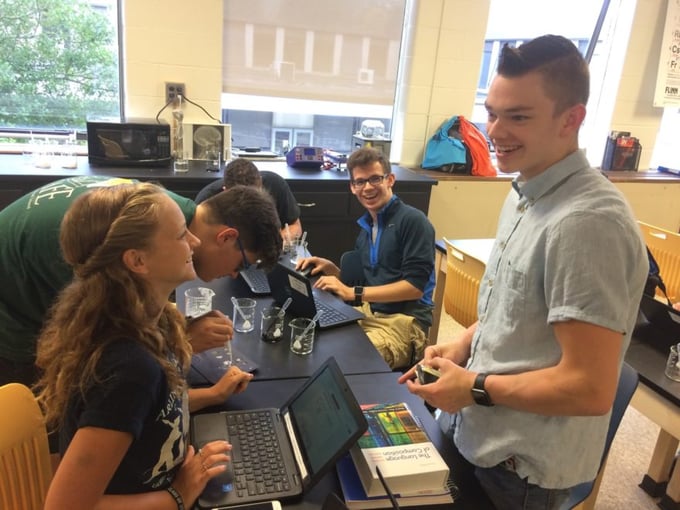Jeffrey Wells is a science teacher at Lancaster High School in Lancaster, Ohio. While Jeffrey has been a teacher for six years, it is his first year teaching any PLTW courses. Jeffrey teaches Principles of Biomedical Science (PBS) and Human Body Systems (HBS), as well physics and STEM physical science courses.
In 2015, Lancaster High School implemented its own STEM program. Through this program, a selected group of ninth grade students were placed in a specialized honors-level physical science and algebra 2 course. This class was a huge success, proving popular with students and parents. The question that our school then faced was how to continue to provide enriching, meaningful STEM-based instruction for these students throughout their four years of high school.
As a result of many, many conversations, we opted to implement PLTW courses. We started with Introduction to Engineering Design (IED), and we are continuing to add classes each year. Currently, we are halfway through our implementation of both PLTW Engineering and PLTW Biomedical Science, with plans of adding the Computer Science Principles (CSP) course and the remainder of the PLTW Biomedical Science courses next year.
Over the two short years of offering the PLTW programs, we have witnessed a dramatic change in our students and our school. The students are now excited to talk about potential college majors and future careers. Learning has become an adventure for them, as they now see how science, math, and engineering connect with one another at a fundamental level. Furthermore, we continually hear from parents about how excited their children are about STEM and school in general. In fact, at a recent parent-teacher conference, a father told me, "I think my son would have lost all interest in school if it wasn't for these classes."
In our biomedical science classes, our students are learning as much about themselves as they are about science. The course activities have opened their eyes to a multitude of potential healthcare-related career paths. In addition, the students love to see the connections between biology, chemistry, and anatomy. Beyond the standard curriculum, each month I have my students divide themselves into small teams, and I present each group with a real-world medical case study. The teams have one month to evaluate their patient's case and determine the final diagnosis. On the last day of each month, each team presents its case study to the class, including the diagnosis, justification of the diagnosis, potential treatment options, and the patient's prognosis. These case studies have sparked excellent conversations among the students, relating the content with patient care and cutting-edge medical research.
Meanwhile, in our engineering classes, the students are continually delving deep into the design process. Through dynamic activities and experiences, the students learn the principles of research, design, and development, all while honing their communication and teamwork skills. One of the hallmarks of our engineering program is the inclusion of real-world experiences for the students. For example, a parent of one of our students recently invited the engineering classes to tour a local large-operation semi-truck manufacturing facility. During the trip, the students were able to see everything from drafting and design to robotics and automotive engineering in real-world practice.
The future is bright for PLTW at Lancaster High School, as junior high students within our district are excited to be on "Team Engineering" or "Team Biomed" when they reach the high school. Our current high school students are ready to tackle the challenges of new courses, and we are even considering the future development of a computer science pathway at our school.
Overall, the addition of the PLTW programs at our school has increased rigor, as well as a desire for students to take on more challenges. There is certainly more collaboration among our students now, as they have learned to take ownership of their learning. These classes have created an environment for students that promotes high standards and project-based learning.
PLTW’s blog is intended to serve as a forum for ideas and perspectives from across our network. The opinions expressed are those of each guest author.


